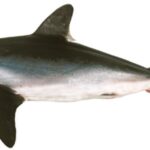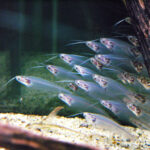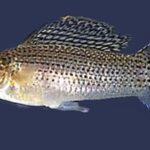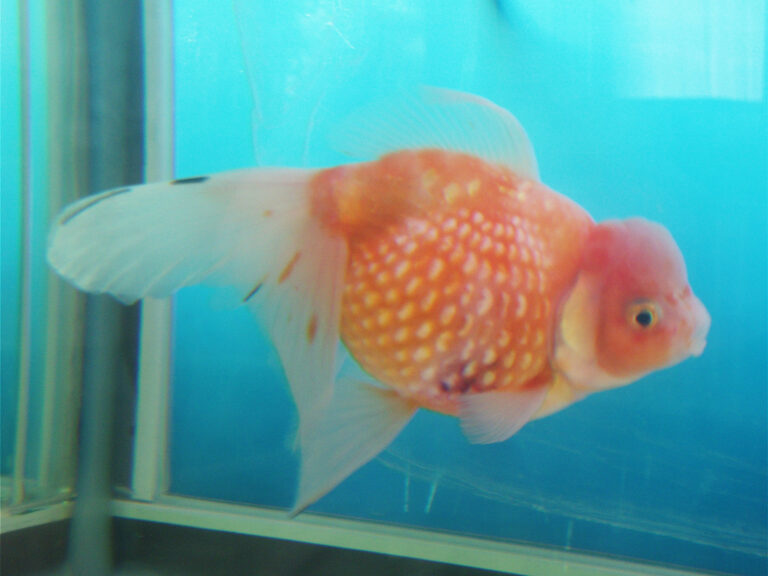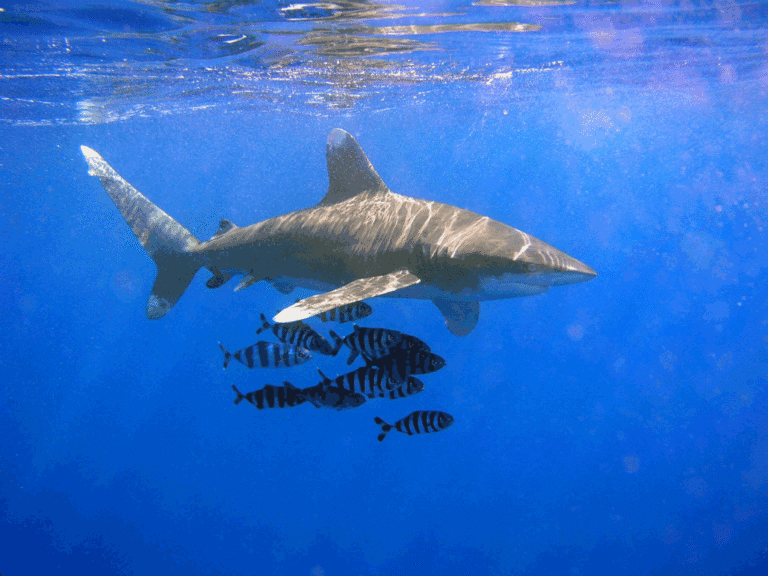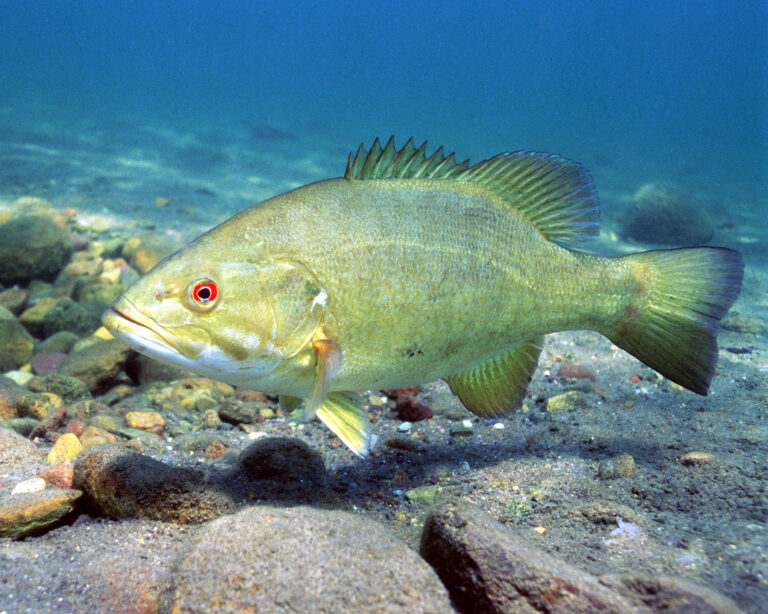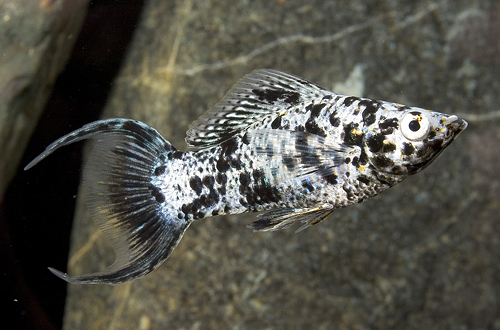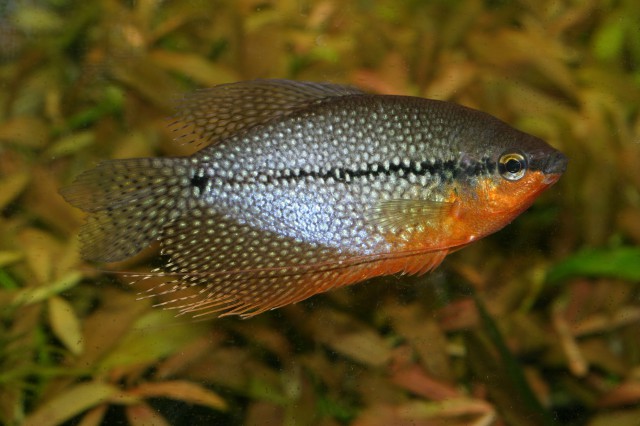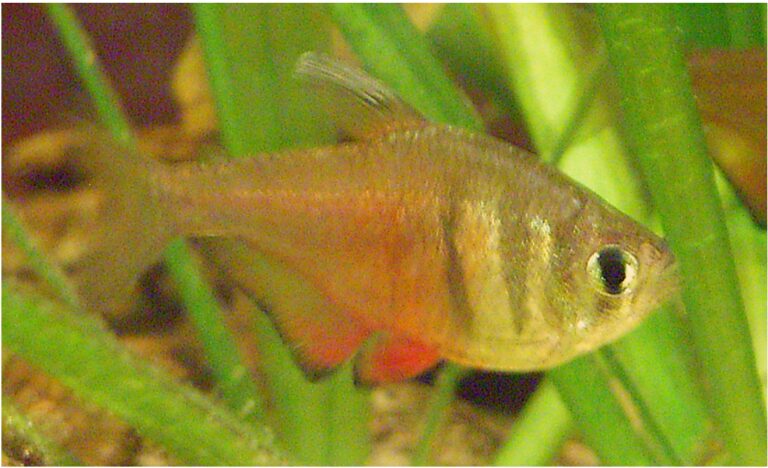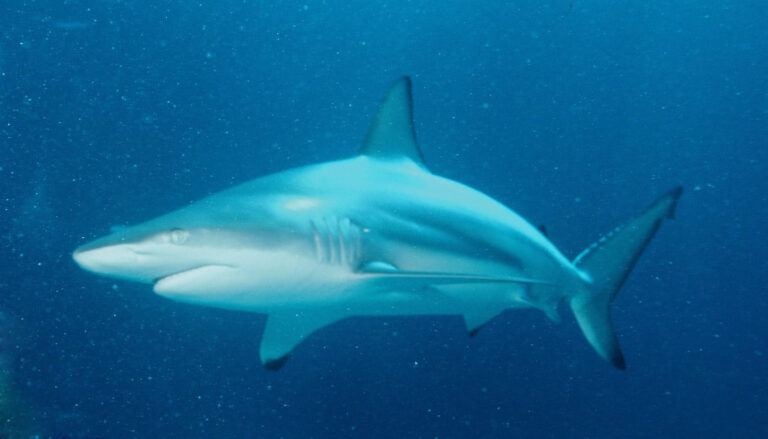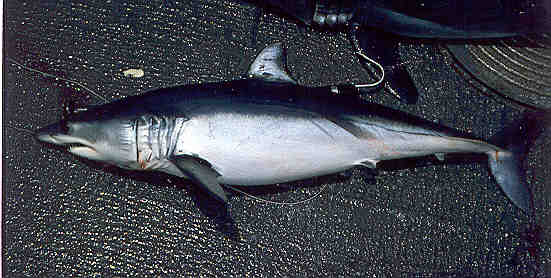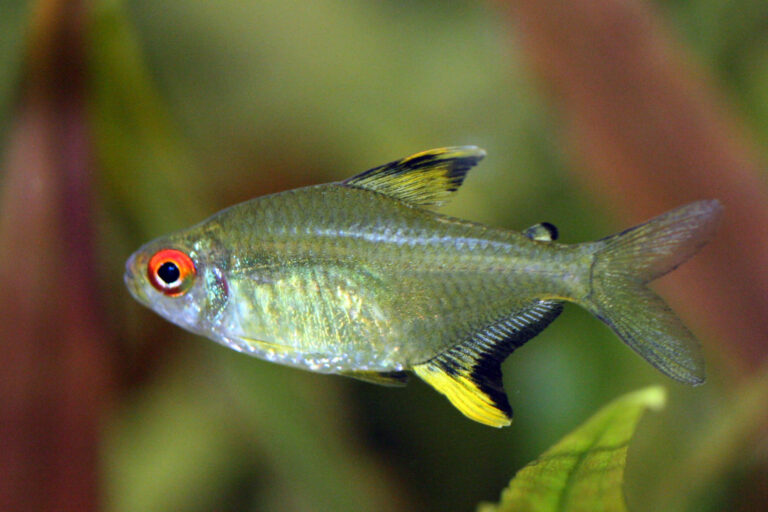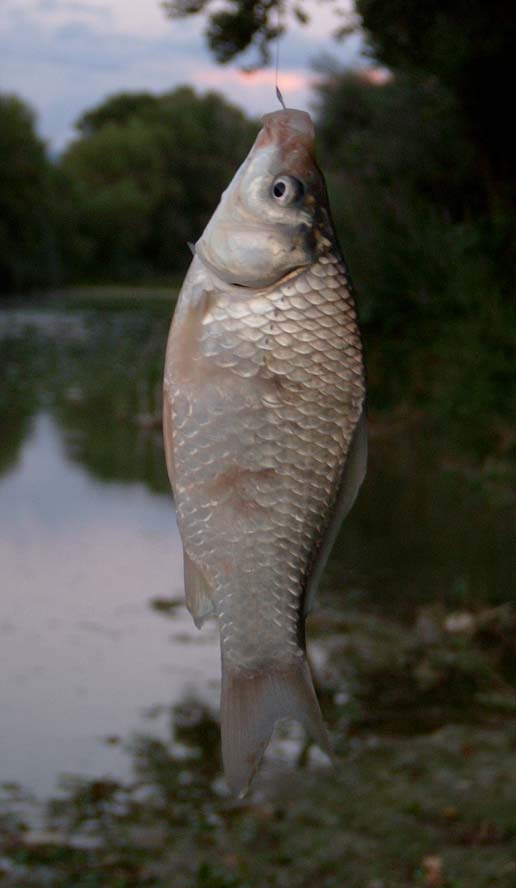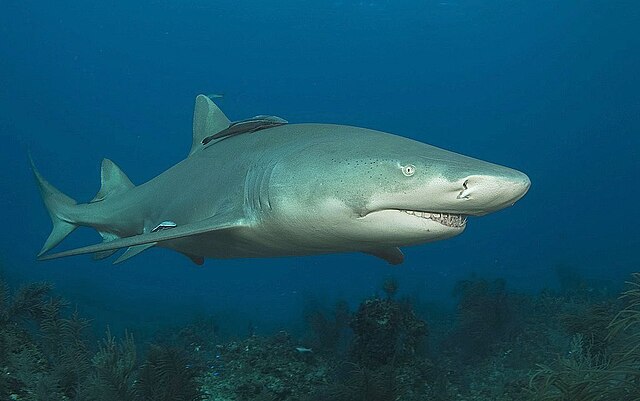Thresher Shark
By Ryan Maron | Last Modified: July 10, 2025
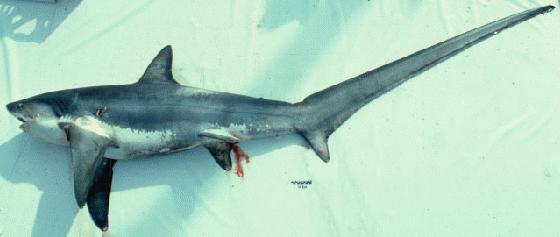
The Thresher Shark represents one of the ocean’s most distinctive and captivating apex predators, renowned for its extraordinarily elongated upper tail fin that can reach lengths equal to the shark’s entire body. These remarkable pelagic sharks, scientifically classified within the family Alopiidae, inhabit warm and temperate waters across the globe, playing crucial roles as both predator and prey in marine ecosystems. The genus Alopias encompasses three recognized species, each adapted to specific oceanic zones and hunting strategies.
Thresher Sharks distinguish themselves from other shark species through their unique hunting methodology, utilizing their weaponized tail to stun schooling fish with powerful strikes. This specialized feeding behavior, combined with their impressive size and distinctive silhouette, makes them among the most recognizable sharks in marine environments. As apex predators, they help maintain the delicate balance of oceanic food webs by controlling populations of smaller fish and cephalopods, while their own numbers face increasing pressure from commercial fishing operations and habitat degradation.
| Feature | Details |
| Common Name | Thresher Shark |
| Scientific Name | Alopias vulpinus |
| Family | Alopiidae |
| Typical Size | 3-6 meters (10-20 feet), 230-500 kg |
| Habitat | Pelagic waters, continental shelves |
| Diet | Schooling fish, cephalopods |
| Distribution | Global temperate and tropical waters |
| Conservation Status | Vulnerable |
Taxonomy & Classification
The Thresher Shark belongs to the order Lamniformes, which includes some of the ocean’s most formidable predators. Within the family Alopiidae, three distinct species have been identified: the Common Thresher (Alopias vulpinus), the Bigeye Thresher (Alopias superciliosus), and the Pelagic Thresher (Alopias pelagicus). Each species exhibits unique morphological adaptations and occupies specific ecological niches within marine ecosystems.
The genus Alopias derives from the Greek word “alopex,” meaning fox, referencing the shark’s cunning hunting behavior and elongated tail reminiscent of a fox’s brush. This taxonomic designation reflects the species’ distinctive characteristics that have evolved over millions of years. Molecular studies have revealed that thresher sharks diverged from other lamniform sharks approximately 50 million years ago, developing their specialized tail morphology as an adaptation to their unique feeding strategy.
The Common Thresher Shark serves as the type species for the family and represents the most widely distributed member of the group. Recent genetic analyses have confirmed the monophyletic nature of the Alopiidae family, distinguishing it from closely related families such as Lamnidae, which includes great white sharks and other mackerel sharks. These taxonomic relationships help scientists understand the evolutionary pressures that shaped the thresher shark’s distinctive anatomy and behavior.
Physical Description
The Thresher Shark’s most striking feature is its dramatically elongated upper caudal fin, which can comprise up to 50% of the shark’s total body length. This massive tail fin, technically called the caudal lobe, serves as both a weapon and a propulsion system, allowing the shark to achieve remarkable swimming speeds and execute its signature hunting technique. The tail’s structure consists of strong cartilaginous support surrounded by dense muscle tissue, enabling the shark to generate tremendous force when striking prey.
The body of a Thresher Shark exhibits the classic fusiform shape optimized for pelagic life, with a streamlined profile that reduces drag during high-speed pursuits. Adult Common Threshers typically measure between 3 and 6 meters in total length, with females generally growing larger than males. Their coloration follows a counter-shading pattern, with dark blue to gray dorsal surfaces that blend with the deep ocean when viewed from above, and lighter ventral surfaces that camouflage against the bright surface waters when observed from below.
The head of a Thresher Shark is relatively small compared to other large shark species, featuring a pointed snout and moderately large eyes positioned laterally on the skull. Their dental arrangement consists of small, curved teeth designed for grasping rather than cutting, reflecting their preference for swallowing prey whole after stunning it with their tail. The gill slits are positioned just behind the head, with the fifth gill slit extending above the pectoral fin base, a characteristic feature that distinguishes thresher sharks from other families.
Thresher Sharks possess well-developed pectoral fins that provide stability during their acrobatic hunting maneuvers. Their dorsal fins are positioned relatively far back on the body, contributing to their distinctive silhouette. The species exhibits subtle sexual dimorphism, with mature males developing claspers for reproduction and often displaying more pronounced scarring from mating encounters.
Habitat & Distribution
Thresher Sharks inhabit pelagic waters across tropical and temperate oceanic regions worldwide, demonstrating remarkable adaptability to diverse marine environments. The Common Thresher shows the broadest distribution, occurring in the Atlantic, Pacific, and Indian Oceans, typically in waters ranging from 16°C to 21°C. These sharks prefer continental shelf areas and nearby oceanic waters, often found at depths between 0 and 500 meters, though they can dive significantly deeper when pursuing prey.
The Bigeye Thresher occupies deeper waters compared to its relatives, frequently inhabiting the mesopelagic zone between 150 and 500 meters depth. This species demonstrates a more tropical distribution, preferring warmer waters above 15°C. The Pelagic Thresher, smallest of the three species, maintains a more restricted range centered around the Indo-Pacific region, particularly abundant in Southeast Asian waters and the central Pacific Ocean.
Thresher Sharks exhibit seasonal migration patterns linked to prey availability and reproductive cycles. In the Pacific, Common Threshers migrate northward along the California coast during summer months, following schools of anchovies and sardines. Similarly, Atlantic populations move between feeding and breeding grounds, with some individuals traveling thousands of kilometers annually. These migration patterns often bring them into contact with coastal waters, where they may be observed by divers and fishermen.
The species demonstrates a preference for areas with high prey density, particularly regions where upwelling currents create productive feeding zones. Seamounts, continental shelf edges, and areas of oceanic convergence serve as important habitat features for thresher sharks. Their distribution patterns closely correlate with the abundance of schooling fish species, making them excellent indicators of marine ecosystem health.
Diet & Feeding Behavior
Thresher Sharks have evolved one of the most specialized feeding strategies in the shark world, utilizing their elongated tail as a weapon to stun schooling fish before consumption. This unique hunting technique, known as “tail slapping,” involves the shark swimming rapidly toward a school of fish and delivering powerful strikes with its caudal fin. The impact can stun or kill multiple prey items simultaneously, allowing the shark to consume them efficiently.
The primary diet of Thresher Sharks consists of schooling pelagic fish species, including anchovies, sardines, mackerel, and herring. They also consume cephalopods such as squid and octopus, particularly during nighttime feeding when these prey species migrate toward the surface. Juvenile threshers supplement their diet with smaller fish and crustaceans, gradually transitioning to larger prey items as they mature.
High-speed photography and underwater observations have revealed the remarkable precision of thresher shark hunting behavior. The sharks can accelerate their tail tip to speeds exceeding 80 kilometers per hour during strikes, creating cavitation bubbles that contribute to the stunning effect. This feeding strategy allows them to exploit schooling fish that other predators might find difficult to catch individually.
Thresher Sharks demonstrate tactical hunting behavior, often working in coordination with other marine predators. They may follow dolphin pods or seabird flocks to locate fish schools, taking advantage of the feeding activity to launch their own attacks. Their feeding patterns show seasonal variation, with increased activity during periods of high prey abundance, particularly during sardine and anchovy spawning seasons.
Behavior & Adaptations
The Thresher Shark exhibits remarkable behavioral adaptations that complement its unique morphology. Most notably, these sharks are capable of impressive aerial displays, launching themselves completely out of the water during feeding or possibly as a form of communication. This breaching behavior, uncommon among large shark species, demonstrates the powerful propulsion generated by their specialized tail fin.
Thresher Sharks display complex social behaviors, particularly during feeding events. While generally solitary, they may aggregate in areas of high prey density, sometimes forming loose associations with other threshers or different shark species. These aggregations can include blue sharks and other pelagic predators, creating competitive feeding scenarios that influence hunting strategies.
The species has evolved sophisticated thermoregulatory mechanisms to maintain optimal body temperature in varying oceanic conditions. Unlike some other large sharks, thresher sharks do not possess a full-scale counter-current heat exchange system, but they do show some degree of regional endothermy, particularly in their eye and brain regions. This adaptation allows them to maintain sensory function in cooler waters encountered during deep dives.
Thresher Sharks demonstrate remarkable swimming efficiency, utilizing their large tail fin for both propulsion and steering. Their swimming patterns often involve long, graceful undulations that minimize energy expenditure during migrations. When hunting, they can rapidly accelerate and execute sharp turns that would be impossible for most other large marine predators.
The species exhibits complex learning behaviors, adapting their hunting techniques based on prey behavior and environmental conditions. Observations suggest that individual sharks may develop specialized hunting preferences, focusing on particular prey species or employing specific tail-slapping techniques that prove most effective in their local environment.
Reproduction & Life Cycle
Thresher Sharks follow a reproductive strategy known as ovoviviparity, where embryos develop within eggs that remain inside the mother until hatching. This method provides protection during the vulnerable early developmental stages while allowing for relatively large offspring at birth. The gestation period varies among species but typically ranges from 9 to 12 months, with Common Threshers showing the longest pregnancy duration.
Female Thresher Sharks typically produce between 2 and 4 pups per litter, though the exact number depends on the species and the mother’s size. The pups are born at a relatively large size, measuring 120 to 160 centimeters in length, which provides them with significant advantages for survival in the pelagic environment. This small litter size, combined with the extended gestation period, results in low reproductive output compared to many other shark species.
The species exhibits a phenomenon known as intrauterine cannibalism, where the largest embryos consume smaller siblings and unfertilized eggs within the uterus. This behavior, while seemingly harsh, ensures that the surviving offspring receive maximum nutrition during development, increasing their chances of survival after birth. The resulting pups are exceptionally well-developed and capable of independent hunting from birth.
Sexual maturity in Thresher Sharks is reached relatively late, with females typically maturing between 7 and 13 years of age, depending on the species. Males generally reach maturity earlier, at around 3 to 7 years. This late maturation, combined with low reproductive output, makes thresher shark populations particularly vulnerable to overfishing and slow to recover from population declines.
Breeding appears to occur in specific areas, with some populations showing site fidelity to particular reproductive zones. These breeding grounds often coincide with areas of high prey abundance, allowing pregnant females to maintain adequate nutrition during the energy-intensive gestation period.
Predators & Threats
Adult Thresher Sharks face few natural predators due to their large size and formidable tail weapon, but they are not without threats in the marine environment. Larger shark species, including great white sharks and tiger sharks, may occasionally prey upon smaller thresher sharks, particularly juveniles. Killer whales represent another significant predator, with documented cases of orca pods successfully hunting adult thresher sharks in various oceanic regions.
Juvenile Thresher Sharks face a broader range of predators during their early life stages. Despite their relatively large size at birth, young threshers remain vulnerable to attacks from various large fish species, marine mammals, and other sharks. The pelagic environment offers limited refuge opportunities, making speed and agility their primary defense mechanisms during this critical period.
The primary threats to Thresher Shark populations stem from human activities, particularly commercial fishing operations. These sharks are highly valued for their large fins, which are sought after for shark fin soup, and their meat, which is consumed in various markets worldwide. Their habit of following fishing vessels and their tendency to leap when hooked makes them particularly vulnerable to longline and gillnet fisheries.
Climate change poses an emerging threat to Thresher Shark populations through alterations in ocean temperature and prey distribution patterns. As warming seas shift the distribution of schooling fish species, thresher sharks may be forced to alter their migration patterns or face reduced prey availability. Ocean acidification may also impact the abundance of their cephalopod prey, potentially affecting their nutritional status and reproductive success.
Pollution represents another significant concern, with thresher sharks accumulating heavy metals and persistent organic pollutants through their position in the marine food web. Plastic pollution poses both direct threats through ingestion and indirect effects through the contamination of their prey species.
Conservation Status
The International Union for Conservation of Nature (IUCN) has classified the Common Thresher Shark as Vulnerable on the Red List of Threatened Species, reflecting significant population declines documented across much of its range. The Bigeye Thresher and Pelagic Thresher face even more severe conservation challenges, with both species listed as Vulnerable to Near Threatened, depending on regional assessments.
Population studies have revealed alarming declines in thresher shark numbers, with some regional populations experiencing reductions of 50% or more over the past several decades. The slow reproductive rate of these species makes recovery particularly challenging, as populations cannot quickly rebound from fishing pressure or other threats. The late age of sexual maturity means that fishing mortality often removes individuals before they have had the opportunity to reproduce.
International conservation efforts have begun to address the threats facing thresher sharks, with several countries implementing fishing restrictions or bans on shark finning. The Convention on International Trade in Endangered Species (CITES) has included thresher sharks in its appendices, regulating international trade in their products. However, enforcement of these measures remains challenging in many regions.
Regional fisheries management organizations have started implementing species-specific measures for thresher sharks, including catch limits, seasonal closures, and gear restrictions. Some areas have established marine protected areas that provide critical habitat protection for these species, though the highly migratory nature of thresher sharks means that comprehensive conservation requires international cooperation.
Research initiatives focused on thresher shark biology, behavior, and population dynamics continue to provide essential data for conservation planning. Satellite tagging programs have revealed previously unknown migration patterns and habitat preferences, informing the development of more effective protection strategies.
Human Interaction
Thresher Sharks have maintained a complex relationship with human communities for centuries, featuring prominently in both commercial fisheries and recreational activities. Their impressive size and distinctive appearance have made them popular targets for sport fishing, particularly in regions where they approach coastal waters during seasonal migrations. The spectacular leaping behavior of hooked thresher sharks has earned them recognition as premier game fish species.
Commercial fishing operations have historically targeted thresher sharks for their valuable fins, meat, and liver oil. The species’ tendency to follow fishing vessels and their susceptibility to various fishing gear types has made them particularly vulnerable to overfishing. In many regions, thresher sharks represent significant bycatch in tuna and swordfish fisheries, often resulting in high mortality rates even when the sharks are not the primary target.
The shark fin trade has created substantial economic incentives for harvesting thresher sharks, with their large fins commanding high prices in Asian markets. This economic pressure has contributed to the development of directed fisheries specifically targeting these species, often using longlines and gillnets that can cause significant ecological damage to marine ecosystems.
Recreational diving and ecotourism have emerged as important alternative economic uses for thresher sharks, particularly in regions where these animals can be reliably observed. Dive operators in locations such as the Philippines, Mexico, and California have developed successful businesses centered around thresher shark encounters, demonstrating the potential economic value of living sharks versus harvested ones.
Educational programs and public awareness campaigns have helped increase understanding of thresher shark ecology and conservation needs. These initiatives often emphasize the species’ unique hunting behavior and ecological importance, helping to build support for conservation measures among coastal communities and recreational ocean users.
Interesting Facts
Thresher Sharks possess several remarkable characteristics that distinguish them from other marine predators. Their tail can generate enough force to decapitate large fish, with strikes measured at speeds exceeding 80 kilometers per hour. This incredible velocity creates cavitation bubbles that contribute to the stunning effect, making it one of the most efficient hunting techniques in the marine world.
The species demonstrates remarkable intelligence in their hunting strategies, with observations documenting cooperative behavior between individual sharks. Some thresher sharks have been observed working together to herd schools of fish, taking turns to deliver tail strikes while their partners position themselves to catch stunned prey. This level of coordination suggests complex social cognition rarely observed in shark species.
Thresher Sharks are among the few shark species capable of maintaining elevated body temperatures in cold water, though their thermoregulatory abilities are less developed than those of other lamniform sharks. This adaptation allows them to remain active in cooler waters encountered during deep dives or in higher latitudes, expanding their available habitat range.
The species exhibits remarkable jumping ability, with Common Threshers capable of launching their entire body several meters above the water surface. This behavior may serve multiple purposes, including parasite removal, communication, and prey stunning. The sight of a 6-meter thresher shark breaching completely out of the water represents one of the most spectacular displays in marine wildlife.
Thresher Sharks have been known to live for several decades, with some individuals estimated to reach ages of 20 to 50 years. Their longevity, combined with their slow reproductive rate, makes them particularly vulnerable to fishing pressure and emphasizes the importance of long-term conservation strategies for maintaining stable populations.
Conclusion
The Thresher Shark stands as one of the ocean’s most remarkable predators, representing millions of years of evolutionary adaptation to pelagic life. Their unique hunting strategy, impressive physical capabilities, and complex behaviors highlight the incredible diversity of marine ecosystems and the specialized roles that different species play in maintaining oceanic balance. As apex predators, thresher sharks help regulate prey populations and contribute to the overall health of marine food webs, making their conservation essential for ecosystem stability. The current threats facing these magnificent creatures underscore the urgent need for comprehensive protection measures and international cooperation to ensure their survival for future generations.
Share The Article:
More Fish Species:
-
Pearlscale Goldfish
The Pearlscale Goldfish represents one of the most distinctive and captivating varieties of ornamental carp, distinguished by its characteristic…
-
Oceanic Whitetip Shark
The Oceanic Whitetip Shark (*Carcharhinus longimanus*) stands as one of the ocean’s most formidable and recognizable apex predators, distinguished…
-
Smallmouth Bass
The Smallmouth Bass represents one of North America’s most prized freshwater game fish, combining impressive fighting ability with remarkable…
-
Lyretail Molly
The Lyretail Molly (*Poecilia latipinna*) stands as one of the most recognizable and ecologically significant freshwater fish species in…
-
Pearl Gourami
The Pearl Gourami stands as one of the most recognizable and ecologically significant members of the labyrinth fish family,…
-
Flame Tetra
The Flame Tetra (Hyphessobrycon flammeus) stands as one of the most recognizable and beloved freshwater aquarium species in the…
Discover
-
Blacktip Shark
The Blacktip Shark (Carcharhinus limbatus) stands as one of the most recognizable and ecologically significant predators in tropical and…
-
History of Fly Fishing: Ancient Origins to Modern Mastery
The gentle art of fly fishing has captivated anglers for centuries, evolving from a practical method of obtaining food…
-
Chinook Salmon: Essential Guide for Catching Kings
There’s something almost magical about the moment when a Chinook salmon takes your lure. That heart-stopping tug, followed by…
-
Yellowfin VS Bluefin Tuna: Which Should You Target? (Expert Guide)
Let’s be honest – the first time I saw a yellowfin and bluefin tuna side by side at the…
-
Great Lakes Fishing Tactics That Nobody Talks About (But Should)
Ever notice how some anglers consistently haul in impressive catches from the Great Lakes while others struggle to get…
-
California Fishing License Guide: Costs, Types & How to Buy (2025)
Getting your California fishing license might seem like a hassle, but it’s actually pretty straightforward once you know the…
Discover
-
Shortfin Mako Shark
The Shortfin Mako Shark stands as one of the ocean’s most remarkable predators, combining exceptional speed with sophisticated hunting…
-
Lemon Tetra
The Lemon Tetra (*Hyphessobrycon pulchripinnis*) stands as one of South America’s most vibrant freshwater fish species, distinguished by its…
-
How to Fish for Bluegill: 2025 Complete Guide
Bluegill might not be the biggest fish in the pond, but they sure make up for it in fight…
-
Goldfish
The goldfish (Carassius auratus) stands as one of the most culturally significant and scientifically fascinating species in freshwater aquaculture…
-
Lemon Shark
The Lemon Shark (*Negaprion brevirostris*) represents one of the most scientifically studied and ecologically significant predators in coastal marine…
-
Fly Tying for Fishing Success: A Practical Guide for Anglers
There’s something deeply satisfying about catching a fish on a fly you’ve tied with your own hands. I still…


